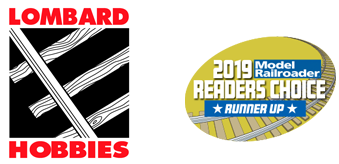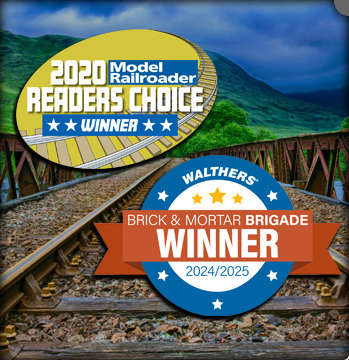ScaleTrains HO
ScaleTrains Rivet Counter HO SXT39206 DCC Ready EMD GP30 Locomotive B&O 'Capitol Dome' B&O #6963
- In Stock:
- 1
- Scale:
- HO
- SKU:
- SXT39206
Description
Please note picture is representative of the item but may not be same road number. Always refer to product description for actual product details.
ScaleTrains Rivet Counter HO SXT39206 DCC Ready EMD GP30 Locomotive
B&O 'Capitol Dome' B&O #6963

A new era continues with the Rivet Counter HO Scale EMD GP30. First introduced in 1961, the GP30 would become one of the most-common locomotives on the rails for the next two decades. Our Rivet Counter series model renders the numerous variations of cabs, dynamic brakes, doors, grilles, trucks, etc. Per the prototype and era, we’ve also incorporated LED lighting effects including front, rear, and side walkway lights; ground lights; printed and lighted number boards; and ditch lights.
Road Number Specific ScaleTrains
- New roadname
- Era: late 1960s to early 1980s
- Series 6900 to 6976; built 10:62-1:63
- Road numbers 6911, 6963 and 6974
- Spread out ‘B&O’ logo
- Plexiglass numberboards
- Road numbers 6922 and 6939
- Closely spaced ‘B&O’ lettering
- Original glass style numberboards
- Closely spaced ‘B&O’ lettering
- Fully-assembled
- Multiple road numbers
- Operating LED-illuminated ground lights on both sides of locomotive*
- Operating LED-illuminated “hemisphere” walkway lights on hood ends, and at end of raised walkway duct*
- Operating LED-illuminated tricolor front and rear flush-mounted class lights with lenses and raised gaskets**
- Cab and rear number boards
- Front and rear multiple unit (MU) hose catch boxes
- 4-hose multiple unit (MU) hose clusters with silver gladhands
- Semi-scale coupler buffer equipped with durable metal semi-scale Type E knuckle couplers
- Front and rear straight uncoupling levers without loop handles
- As-delivered pilot faces without uncoupling lever loop notches
- Deck-mounted multiple unit (MU) receptacle
- “Short” stepwells with see-through steps
- Handrail set with center gangway chains
- Front and rear standard drop steps
- Scale sectioned treadplate detail with EMD early “X” style pattern
- 81” GP30 low short hood with ratchet handbrake and square sand fill
- Hinged battery box doors with early hinges and narrow louvers
- Early cab sub-base doors with early hinges
- Front standard EMD LED-illuminated headlight with lenses on number board housing
- GP30 cab with equal length on both sides and inverted cab heater vents
- Detailed cab interior with separate floor, rear wall, seats, and standard AAR control stand
- No cab vents
- Sliding cab side windows
- Tall clear wind wings with mirror at top mounted fore and aft of cab side window on both sides of cab
- Short sunshade with long sunshade tracks
- Lost-wax brass cast Leslie SU-3L-R horn mounted on right side cab eave
- Radio “whip” antenna on number board housing
- Accurate hood door and long hood detail
- Late single-panel inertial compartment
- Wire inertial air intake grills
- Short turbo exhaust stack
- Standard-range dynamic brakes with 48” fan
- Late See-through dynamic brake intake grills with horizontal wires through vertical vanes
- 6-horizontal rib radiator intake grills
- See-through front and rear 48” radiator fan housings with 8-blade fans; 36” pan-top center radiator fan
- Curved radiator fan grab iron
- Square door-style sand fill door on right side hood end
- Rear LED-illuminated horizontal headlight with lenses
- Underbody frame rail with separate plumbing
- Detailed Blomberg-B trucks with Hyatt bearing housings; elliptical springs; end transom detail; separate sanding lines and brackets;
- and separate swing hanger detail
- Dimensionally accurate truck centers
- Speed recorder mounted to second axle on right front truck sideframe
- Frame-mounted bronze bell
- No underbody air filter
- 2,600-gallon fuel tank with vertical gauges and fuel fill in sill skirt; round gauges in fuel tank sides
- Factory-applied wire grab irons, photoetched lift rings, windshield wipers, trainline hoses with silver gladhands, air tanks, sand hatch covers and more
- Motor with 5-pole skew wound armature
- Dual flywheels
- All-wheel drive
- All-wheel electrical pick-up
- Directional LED-illuminated headlights
- Printing and lettering legible even under magnification
- Operates on Code 70, 83 and 100 rail
- Packaging safely stores model
- Minimum radius: 18”
- Recommended radius: 22”
DCC & sound equipped locomotives also feature:
- ESU LokSound 5 DCC & Sound decoder with “Full Throttle”
- Two (2) cube-type speakers
- 16-cylinder 567D3 prime mover sound
- ESU designed “PowerPack” with two super capacitors***
- Operates on both DC and DCC layouts*****
DC/DCC & sound-ready locomotives also feature:
- Operable on DC layouts*****
- DCC-ready with 21-pin connector
* Lighting features operate when using an ESU decoder with appropriate programming while operating using DCC
** Class lights illuminate in white color only in DC operation.
Access and changing colors requires an ESU decoder with appropriate programming while operating using DCC
***“PowerPack” feature only compatible with appropriately programmed ESU decoders operating on a DCC layout
*****Lombard Hobbies Recommendation - As modelers ourselves we highly recommend ONLY running DCC on DCC systems and DC on DC systems, regardless of 'Dual-Mode' capability. This gives optimum performance and safeguards the unit from possible damage from running on a different system than originally intended and from any inexperienced operator errors.
Prototype History:
n the late 1960s to the early 1980s, the Baltimore & Ohio Railroad (B&O) ushered in a new era of diesel-electric locomotives with the introduction of the EMD GP30 series. Constructed between October 1962 and January 1963, these locomotives, numbered 6900 to 6976, represented a significant leap forward in technology and design for the B&O's motive power fleet.
Within this series, units like 6911, 6963, and 6974 became stalwarts of B&O's rail network, contributing to the railroad's efficiency and power in both local and mainline service. One distinct visual feature on the four-axle locomotives was the spread-out “Capitol Dome” logo, proudly displayed on the short and long hoods. Specific GP30 units like 6922 and 6939 featuring closely spaced 'B&O' lettering.
In the 1970s, plexiglass numberboards replaced the original glass. This decision underscored the railroad's commitment to maintaining a reliable and visually appealing fleet of locomotives even over a decade after they were built. The plexi number boards were a slightly different font and were easy to spot by the local railfan.
Chessie System was formed on February 26, 1973, through the merger of three major railroads: the Baltimore & Ohio Railroad (B&O), the Chesapeake & Ohio Railway (C&O), and the Western Maryland Railway (WM). The merger aimed to create a more efficient and competitive railroad system by combining the strengths and resources of the three companies. As a result, ownership of B&O’s GP30s was transferred to the new company.
The Chessie System's distinctive logo featured the image of a sleeping kitten known as "Chessie," which became an iconic symbol of the merged railroad. While many ex-B&O GP30s were repainted into the new kitten scheme, some continued to soldier on well into the late 1980s on the CSX roster. In fact, all road numbers in this run ended up on the CSX roster wearing their original B&O paint until being retired or rebuilt as RDMT Slugs around 1991.
Lombard Hobbies - Your #1 Largest Authorized ScaleTrains Select Retailer!































